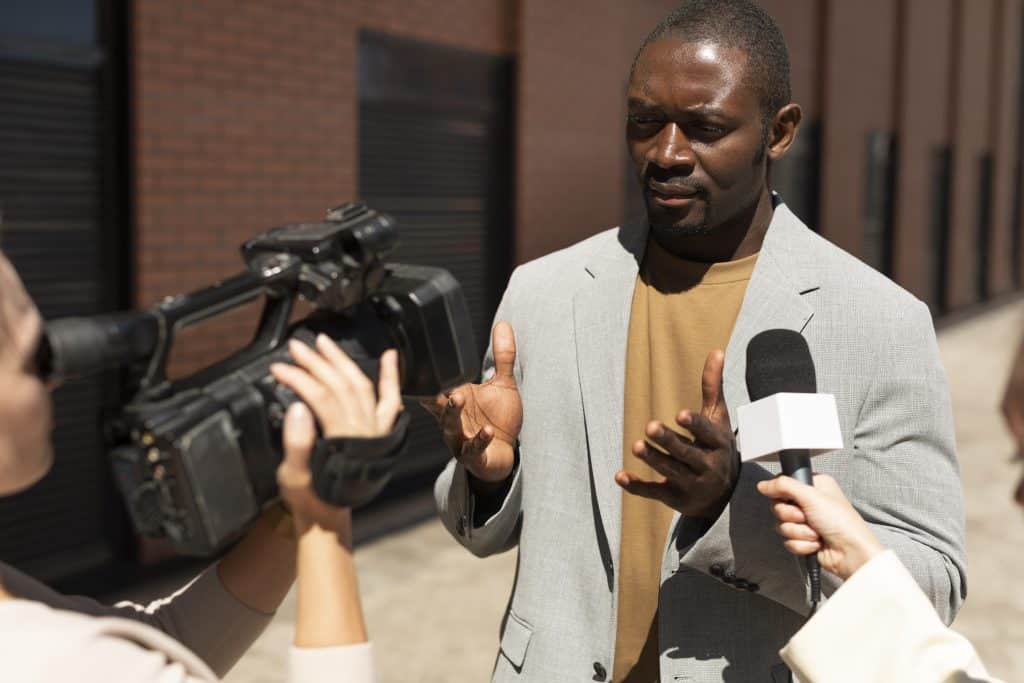South Africa violence misinformation: Understanding its roots

Anúncios

In recent years, South Africa violence misinformation has become a pressing issue, significantly affecting public perception, safety, and policy.
As social media and the internet continue to evolve, the speed and reach of false narratives have escalated, creating significant challenges.
Anúncios
It’s essential to explore the origins of this misinformation, its real-world consequences, and the collective responsibility we share in addressing it.
Are you aware of how misinformation can skew perceptions of safety in the country? This article explores these dynamics and how we can take action to mitigate their impact.
The Rise of Misinformation in South Africa: A Growing Threat to Public Trust and Safety
The rise of misinformation in South Africa has become an urgent and growing concern, deeply impacting communities across the nation.
Anúncios
As access to the internet and social media increases, so does the potential for false information to spread at an unprecedented rate.
This wave of misinformation distorts public perception, affecting the safety of individuals and communities, and influencing policies that shape the nation’s future.
To effectively address this issue, it is crucial to understand where this misinformation originates and how it impacts society at large.
Understanding the Sources of Misinformation in South Africa
Misinformation in South Africa does not stem from a single source; it is fueled by a variety of factors.
While traditional media outlets sometimes play a part, social media platforms serve as the primary accelerants, amplifying false narratives to vast audiences in a matter of hours.
This rapid spread of misinformation can create public panic, unrest, and confusion, ultimately eroding public safety and trust.
Key Contributors to Misinformation in South Africa
Several factors contribute to the spread of South Africa violence misinformation:
- Social Media Platforms: Social media platforms like Facebook and Twitter play a central role in spreading both accurate news and misinformation. These platforms’ open nature allows false information to be shared widely, especially when it is sensational or emotionally charged.
- Influencers and Public Figures: Statements made by influential public figures can often unintentionally or deliberately mislead large followings. These statements may gain credibility, making it more difficult to distinguish fact from fiction.
- Rumors and Local Gossip: In many South African communities, rumors and gossip can rapidly change how people perceive certain events or individuals. These informal sources often exacerbate fear, creating misunderstandings that affect community dynamics.
- Political Agendas: Some misinformation is strategically disseminated to serve political interests, intentionally manipulating public opinion for political gain. This type of misinformation can deepen societal divisions, making it harder to address the root causes of issues.
As misinformation spreads unchecked, communities become increasingly divided. The growing polarization stems from a lack of accurate information and the widespread acceptance of false narratives.
South Africa violence misinformation often contributes to rising tensions, making it more difficult to find common ground among different groups.
Education: A Key Solution to Combat Misinformation
One of the most effective tools for combating South Africa violence misinformation is education.
Media literacy plays a crucial role in equipping individuals with the ability to critically assess the information they encounter.
By learning how to identify reliable sources, individuals can better differentiate between fact and fiction.
Schools, local organizations, and community centers can play a significant role in promoting critical thinking and media awareness.
The Role of Technology in Misinformation
Technology, especially the algorithms used by social media platforms, is another key player in the spread of misinformation.
These algorithms often prioritize sensational or emotionally charged content over factual reporting, which leads to the rapid spread of misleading information.
Social media platforms can inadvertently create echo chambers, where users only encounter information that aligns with their existing beliefs, reinforcing their understanding of the world in a biased manner.
Collaborative Efforts to Curb Misinformation
To effectively address the rise of misinformation in South Africa, collaboration between media outlets, fact-checkers, and tech companies is essential.
Initiatives aimed at promoting transparency and accountability within these sectors can help restore public trust.
By encouraging the responsible sharing of information and prioritizing fact-checking, we can significantly reduce the harmful impact of misinformation.
In summary, combating the rise of misinformation in South Africa requires a multi-pronged approach involving education, technological solutions, and collaboration across various sectors.
Only by working together can we mitigate the damaging effects of South Africa violence misinformation and build a more informed, safer society.
How Social Media Spreads False Narratives: Unraveling the Digital Influence of South Africa Violence Misinformation
Understanding how social media spreads false narratives is crucial when addressing the rise of South Africa violence misinformation in today’s digital age.
Misinformation travels rapidly across various platforms, often leading to misunderstanding, panic, and the alteration of public perception.
With just a few clicks, false stories about South Africa violence misinformation can be shared widely, affecting behaviors, communities, and even public policy.
The speed and scale at which these false narratives spread on social media make it essential to comprehend the mechanisms driving this phenomenon.
The Mechanisms of Misinformation Spread on Social Media
Social media platforms enable anyone to share information, both true and false. This openness can be a double-edged sword, especially when it comes to South Africa violence misinformation.
These platforms often prioritize engagement, meaning that sensational or shocking content about violence in South Africa is more likely to be seen than factual news.
This leads to misinformation being shared widely before it can be verified, resulting in a skewed perception of South Africa violence misinformation that can affect real-world behavior.
Key Factors That Contribute to the Spread of South Africa Violence Misinformation
Several factors amplify the spread of South Africa violence misinformation across social media:
- Viral Content: Content that evokes strong emotions like fear, outrage, or shock is more likely to be shared. In the case of South Africa violence misinformation, this type of content spreads rapidly, distorting the truth and fuelling unnecessary panic.
- Echo Chambers: Social media platforms often create echo chambers, where people follow others who share their views, reinforcing biases. This dynamic is particularly harmful when it comes to South Africa violence misinformation, as it prevents users from encountering accurate information and strengthens false narratives.
- False Authority: When influential figures share misinformation related to violence in South Africa, it gains credibility. Followers are more likely to accept these false narratives as truth, amplifying the spread of South Africa violence misinformation.
- Algorithms: Social media algorithms favor posts that receive quick reactions, like likes, comments, and shares. As a result, sensational content, including South Africa violence misinformation, tends to get more visibility than factual information, further spreading misleading narratives.
These factors combine to create a cycle in which South Africa violence misinformation spreads quickly, is accepted as fact, and continues to influence public perception and behavior without proper verification.
The Consequences of South Africa Violence Misinformation
The consequences of South Africa violence misinformation can be devastating. False narratives about crime, violence, or public safety in South Africa can lead to unnecessary panic, fear, and division within communities.
Misinformation may escalate existing tensions, making it harder for communities to work together toward solutions.
For example, during times of crisis or national emergencies, such as during a rise in violence or political unrest, South Africa violence misinformation can disrupt efforts to address these issues.
It can hinder the effectiveness of public health initiatives, mislead the public, and create more violence and unrest.
Misleading claims about security threats or criminal activity can also interfere with law enforcement efforts, ultimately making communities less safe.
Encouraging Critical Thinking to Combat South Africa Violence Misinformation
The most effective way to address South Africa violence misinformation is to encourage critical thinking and promote media literacy.
By educating individuals on how to evaluate information and verify sources, we can prevent South Africa violence misinformation from spreading unchecked.
Media literacy programs can help people recognize the signs of misinformation, ensuring that South Africa violence misinformation does not distort their perceptions or behaviors.
Platforms can also play a crucial role in this process by prioritizing verified information and improving algorithms to limit the reach of sensationalized content.
By encouraging users to fact-check information before sharing, we can collectively reduce the impact of South Africa violence misinformation on public safety and social trust.
In conclusion, South Africa violence misinformation is a significant issue, but it can be mitigated through media literacy, critical thinking, and collaboration.
By promoting responsible sharing and creating systems for fact-checking, we can create a more informed society where South Africa violence misinformation no longer holds the power to divide or harm communities.
Together, we can reduce the spread of misinformation and work toward a safer, more transparent future for South Africa.
Case studies of violence and misinformation

Examining case studies of violence and misinformation is crucial in understanding the severe real-world consequences that arise from false narratives.
These incidents illustrate how quickly misinformation can escalate situations, leading to increased violence and social unrest.
By analyzing specific examples, we can gain insight into how misinformation spreads and the deep effects it can have on society.
Case Study: The Fire Incident
One notable case involved a fire incident that was reported inaccurately on social media. A post falsely claimed that a group of individuals was responsible for setting the fire.
This misinformation spread quickly, leading to immediate backlash against innocent members of the community.
As false claims circulated, a mob formed to confront the alleged perpetrators, resulting in unnecessary violence and heightened community tensions.
The spread of misinformation in this case was alarming. A simple post triggered a chain reaction that escalated into real-world violence.
This example highlights how rapidly South Africa violence misinformation can spiral out of control, turning a false narrative into a violent confrontation.
Case Study: Community Tensions
Another case focused on a rumor related to violence at a local event. Misinformation about a supposed attack began circulating online before the event even took place.
The false claims caused panic, leading many people to avoid the event entirely, even though there was no threat.
Despite the original claims being baseless, fear spread like wildfire within the community, resulting in the cancellation of the event and further dividing local residents.
This case demonstrates how misinformation can disrupt community life, creating unnecessary fear and distrust.
The rapid spread of South Africa violence misinformation fueled panic and prevented individuals from participating in events that could have strengthened community bonds.
Key Impacts of Misinformation
The consequences of South Africa violence misinformation can be devastating and wide-reaching.
Here are some key impacts of how misinformation influences both individuals and communities:
- Heightened Fear: False claims create unnecessary anxiety among residents. Misinformation often causes people to fear situations that aren’t actually dangerous, leading to irrational decisions and actions.
- Loss of Trust: Misinformation causes communities to lose trust in each other. False narratives can divide people, making it harder to build strong social connections. When people no longer trust the information they receive, it erodes social cohesion.
- Increased Violence: Misunderstandings, especially when fueled by misleading information, can escalate into violence very quickly. These tensions may result in direct confrontations, as seen in the fire incident mentioned above.
- Interference with Law Enforcement: Misinformation can interfere with law enforcement’s ability to manage real incidents. Police may be diverted to address fabricated claims, wasting valuable resources and preventing them from responding to actual threats effectively.
These case studies serve as important reminders of the dangers posed by misinformation. They underscore the necessity for responsible sharing of information and verifying facts before spreading any claims.
By focusing on promoting accurate information, we can help reduce the harmful impact of South Africa violence misinformation and prevent unnecessary harm to communities.
The Path Forward: Minimizing the Impact of Misinformation
Addressing the challenges posed by South Africa violence misinformation requires collective efforts from individuals, community leaders, and media organizations. Ensuring the responsible dissemination of information is critical.
Promoting media literacy and encouraging open, transparent communication are essential to minimizing the negative effects of misinformation.
By strengthening community bonds and fostering a culture of fact-checking and responsible sharing, we can help mitigate the adverse impact of misinformation.
In doing so, we will contribute to creating a safer, more informed society where the spread of false narratives no longer fuels unnecessary violence and division.
Impact on public perception and policy
The impact of misinformation on public perception and policy is often underestimated, but it has significant consequences for communities and governance.
When false information spreads, it has the power to dramatically alter how people view critical issues, influencing their beliefs, behaviors, and political priorities.
This shift in perception can lead to changes in policies that are enacted by local and national leaders, often in response to public pressure fueled by misinformation.
Shaping Public Opinion
One of the most significant effects of misinformation is its ability to shape public opinion. False narratives, particularly those surrounding crime rates, social issues, or health concerns, can alter how communities perceive these issues.
For example, if a false narrative about crime rates circulates, it can lead the public to demand stricter law enforcement policies or harsher penalties.
This often stems from fear rather than factual evidence, and when leaders respond to these demands, they may prioritize punitive measures over community support or preventive strategies.
The result is that misinformation becomes a driving force in shaping public opinion, regardless of the truth. It distorts people’s understanding of real issues and diverts attention from effective solutions that focus on addressing root causes.
When South Africa violence misinformation spreads, it can cause people to overestimate crime rates, increasing public support for measures that may not necessarily improve safety or well-being.
Influencing Policy Decisions
Misinformation has a direct influence on policy decisions, especially when political leaders feel the pressure to act in response to public concerns. This pressure often results in hasty decisions that can lead to ineffective policies.
When misinformation takes hold, leaders may rush to enact policies without thoroughly considering the underlying facts.
This can lead to several consequences:
- Poor Policy Choices: Decisions made in haste can overlook the root causes of issues.
- Increased Funding for Law Enforcement: Misinformation can push for policies that favor policing over community resources.
- Neglect of Public Health Measures: Misconceptions about health initiatives can hinder necessary funding and support.
- Polarized Community Responses: Misinformation creates divisions, making it harder to build consensus on important issues.
The Role of Media Literacy in Countering Misinformation
To combat the harmful effects of misinformation on public perception and policy decisions, it is essential to promote media literacy.
By teaching individuals how to evaluate the credibility of sources and identify misinformation, we can empower people to make informed decisions and reduce the influence of false narratives.
Media literacy equips individuals with the tools to recognize reliable sources and distinguish between fact and fiction, helping to minimize the impact of South Africa violence misinformation on public opinion.
When communities are educated about media literacy, they become less vulnerable to manipulation and are more likely to advocate for policies that are grounded in reality.
This leads to a healthier public discourse where leaders prioritize effective, evidence-based policies over reactionary decisions driven by misinformation.
In conclusion, addressing the impact of misinformation on public perception and policy requires a comprehensive approach.
By promoting media literacy, encouraging critical thinking, and fostering responsible information sharing, we can ensure that policies are based on truth, not fear or misunderstanding.
This will help create a more informed society where public safety, health, and social issues are addressed with care and understanding, rather than reacting to the damaging influence of South Africa violence misinformation.
Combating misinformation: What can be done?
Combating misinformation is critical to maintaining a healthy society. The widespread impact of misinformation, especially in today’s digital age, cannot be underestimated.
It is essential for everyone, including individuals, organizations, and leaders, to recognize their role in addressing this issue. By taking proactive steps, we can significantly reduce the spread of false narratives and promote a better-informed public.
In doing so, we can mitigate the harmful effects of misinformation, especially South Africa violence misinformation, on our communities and societal well-being.
Promoting Media Literacy
Education plays a powerful role in fighting misinformation. One of the most effective ways to combat false narratives is by teaching individuals how to critically analyze information.
Media literacy programs can equip people with the skills to evaluate sources, differentiate between fact and fiction, and recognize biased or misleading reporting.
Encouraging Responsible Sharing
Encouraging responsible sharing of information is a crucial aspect of combating misinformation. Every individual has the power to contribute to the spread of truth by pausing to verify information before passing it on.
Thoughtful sharing can drastically reduce the impact of false narratives.
Key actions for responsible sharing include:
- Fact-Checking: Always verify the information before sharing it. Take a moment to check reliable fact-checking websites or consult experts to confirm the validity of the claims you encounter.
- Source Evaluation: Look for reputable and trusted sources. Ensure that the information comes from credible organizations or individuals with a proven record of reliability.
- Awareness of Bias: Be aware of personal biases and how they may influence judgment. Ask yourself if your personal opinions or emotions might be affecting your perception of the information being shared.
- Questioning Headlines: Sensational headlines often lead to misleading content. Instead of immediately sharing, take the time to read the full article or look for additional sources to ensure accuracy.
By making these practices a habit, individuals can play a significant role in curbing the spread of misinformation and reducing its harmful effects on society, particularly concerning sensitive topics like South Africa violence misinformation.
Future outlook on media integrity in South Africa

The future outlook on media integrity in South Africa is a topic of great significance. As misinformation continues to rise, safeguarding the integrity of media reporting becomes essential for a healthy and functioning democracy.
The challenges presented by South Africa violence misinformation highlight the urgent need for accurate and trustworthy journalism.
By understanding the opportunities and obstacles ahead, we can shape a more informed society that values the truth and promotes responsible reporting.
The Role of Technology
Technology will play a pivotal role in strengthening media integrity in South Africa.
The development and implementation of artificial intelligence (AI) and machine learning technologies can provide valuable tools to help media organizations identify and filter out false information.
These tools allow for real-time verification, significantly improving the accuracy of reporting and reducing the spread of South Africa violence misinformation.
- AI and Machine Learning: These technologies can analyze massive amounts of data to identify patterns in misinformation and flag false content before it reaches the wider public.
- Real-Time Fact-Checking: Automated fact-checking systems can enable news outlets to verify claims quickly, ensuring that only credible information is shared with the public.
While technology can assist in combating misinformation, it must be used responsibly.
Technology should not only be about filtering content but also about ensuring that media outlets prioritize transparency and accountability, especially when it comes to sensitive topics like South Africa violence misinformation.
Regulatory Changes
Proposed regulatory changes may also shape the media landscape. There might be discussions about implementing stricter guidelines for media outlets. This could include:
- Accountability Measures: Ensuring that media sources are held responsible for published content.
- Transparency Requirements: Demanding that media outlets disclose their funding and sources.
- Support for Fact-Checking: Promoting initiatives that support independent fact-checking organizations.
- Education Initiatives: Establishing programs that teach media literacy in schools.
As the public becomes more aware of misinformation, there is a growing demand for quality journalism. News organizations that prioritize integrity will likely gain trust and respect from their audiences.
Consequently, this could lead to an increase in demand for fact-checked articles and reliable news sources.
Community involvement is essential as well. Encouraging local communities to engage with journalists can foster better understanding and collaboration.
Active participation from citizens can help ensure reporters focus on issues that matter to the public.
Overall, the future of media integrity in South Africa hinges on collaboration between news organizations, technology companies, and the public.
By working together, we can create an informed society that values accurate information and fosters a vibrant democracy.
Combating South Africa Violence Misinformation Together
In conclusion, tackling South Africa violence misinformation is not just about stopping the spread of false narratives.
It is about restoring trust, safety, and accountability in our communities. Misinformation affects not only public perception but also the policies that shape the future of South Africa.
It can lead to heightened fear, polarized communities, and increased violence, creating a ripple effect that touches every corner of society.
To combat this, we must first empower individuals with the tools to critically assess the information they consume. Promoting media literacy is paramount to building an informed public who can distinguish between fact and fiction.
The role of social media platforms and technology companies is crucial in this fight as well.
They must take more responsibility in filtering out false content and ensuring that verified information reaches the public, rather than sensationalized or misleading stories.
As we have seen in numerous case studies, such as the fire incident or community tensions fueled by rumors, the spread of misinformation can directly lead to violence and social unrest, emphasizing the importance of preventing it.
Moreover, collaboration among fact-checkers, media outlets, and community leaders is essential.
By working together, we can ensure that South Africa violence misinformation is confronted with credible, transparent, and accurate information.
By fostering open dialogue, increasing fact-checking efforts, and pushing for more accountability from news organizations and social media platforms, we can mitigate the harmful effects of misinformation on public safety and societal trust.
Finally, the responsibility does not solely lie with the government or media. Each of us has a role to play in sharing truthful information and questioning narratives that seem misleading or sensationalized.
As we strive for a future with greater media integrity, it is crucial to remain vigilant and proactive, always keeping in mind the potential consequences of South Africa violence misinformation on our communities.
By embracing these approaches and continuing to educate and engage with the public, we can pave the way for a more informed, safer, and more connected South Africa.
For further insights on this critical topic, explore the reports on China Daily and UCT News.
FAQ – Frequently Asked Questions about Combating Misinformation in South Africa
What is misinformation?
Misinformation refers to false or misleading information that is spread, regardless of intent.
How can media literacy help in combating misinformation?
Media literacy educates individuals on how to evaluate sources and discern fact from fiction, reducing the spread of false narratives.
What role do social media platforms play in misinformation?
Social media platforms can unintentionally amplify misinformation through their algorithms, which prioritize engaging content over accuracy.
How can communities help reduce misinformation?
Communities can engage in discussions, promote fact-checking initiatives, and support local journalism to foster an informed public.
Liked the article?





